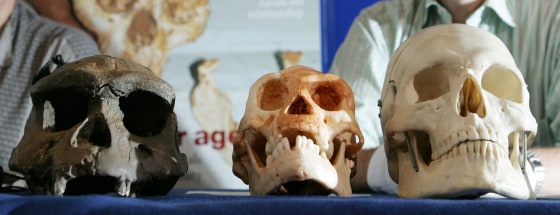Scientists are gearing up to use a new drilling technique to extract ancient DNA from an 18,000-year-old tooth that belonged to a "hobbit," the mysterious, diminutive creatures that once lived on the Indonesian island of Flores.
If successful, a comparison of the DNA with other species could help resolve disputes surrounding who the hobbits were and where they originated.
Peter Brown, a paleoanthropologist at the University of New England in Armidale, Australia, described and named the species Homo floresiensis in 2004, though he and other scientists now suspect the hobbit's ancestors may have left Africa before the genus Homo evolved.
Other researchers contend the approximately 4-foot-tall hobbits were modern humans who perhaps suffered a genetic condition that causes dwarfing, or were nutritionally deficient.
New technique
Previous attempts to extract DNA from a hobbit tooth excavated in 2003 failed, including one effort by a team based at the Australian Center for Ancient DNA. Some members of that team are involved with the new attempt on a tooth excavated from the Liang Bua cave on Flores in 2009, Nature News reports.
The previous failures may be due to techniques used to extract DNA, according to Christina Adler, a geneticist at ACAD who is leading the new attempt.
She and her colleagues found that while most genetic research on ancient teeth focuses on inner tooth tissue, which is called dentin, the coating of the root, called cementum, is a source of richer DNA. In addition, teams often drill into teeth at the relatively high speed of 1,000 revolutions per minute, which generates heat that rapidly destroys DNA. Going slower — 100 rpm — appears to alleviate the problem.
These results have been accepted for publication in the Journal of Archaeological Science.
Adler and her colleagues will target cementum and drill at the slower speed when they attempt to extract DNA from the premolar excavated in 2009.
Chances at success?
Whether the technique will work is unknown. "No attempts at getting DNA from fossils from warm climes have been successful so far," Richard Potts, director of the human origins program at the Smithsonian Institution, told me today via e-mail.
But once a technique to extract ancient DNA is proven successful, he added, "it is only a matter of time before the African roots of Homo sapiens are explored with the technique, which will enable researchers to test ideas that have arisen about Neanderthals, the possibility of interbreeding with Homo sapiens, and other questions besides the intriguing ones about the hobbits."
Matthew Collins, a specialist in ancient protein analysis at the University of York in Britain, told Nature News that the tropical climate on Flores has probably fragmented the ancient DNA in the hobbit tooth too much to yield worthwhile results. The ACAD scientists, however, will press ahead, encouraged by their successful extraction of DNA from a 6,000-year-old pig tooth from the site in 2007, according to Nature News.
More stories on the "hobbit" controversy:
- Ancient hobbit-sized human species discovered
- Scientists say 'hobbit' was not modern human
- Hobbit or not? Species debate flares up
- Virtual reality maps real-life 'Hobbit' brain
- Hobbits linked to nutritional deficiency
- Indonesian villages cashing in on 'hobbit' craze
John Roach is a contributing writer for msnbc.com. Connect with the Cosmic Log community by hitting the "like" button on the Cosmic Log Facebook page or following msnbc.com's science editor, Alan Boyle, on Twitter (@b0yle).
